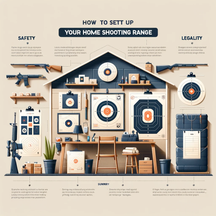Posted by Torres Targets on Feb 24th 2024
How to Set Up Your Home Shooting Range with Paper Targets
Setting up a home shooting range can be a rewarding way to practice your shooting skills safely and conveniently. With the right approach and materials, you can create an effective area tailored to your training needs. This guide outlines the steps to set up a home shooting range using paper targets, emphasizing safety and efficiency.
Step 1: Determine the Location
Selecting the right location is crucial for the safety and legality of your home shooting range. Look for an area that is not only far from populated spaces to minimize risk but also complies with all local and state regulations regarding discharge of firearms. An ideal location will have a natural backstop, such as a hill, to catch bullets safely. If such a natural feature isn't available, you may need to construct a backstop using sand, dirt, or other bullet-absorbing materials. Before finalizing your spot, consult with local law enforcement or a legal advisor to ensure your range meets all legal requirements (Our lawyer advised us to say this).
Step 2: Design Your Range Layout
A well-thought-out layout is essential for a functional and safe shooting range. Start by determining the shooting lanes—the paths your bullets will travel. These should be directed towards your backstop with no possibility of stray bullets leaving the range. Designate specific areas for different shooting distances, allowing for versatility in practice. If you're interested in tactical training, create lanes with barriers or obstacles for a more dynamic shooting experience. Safety zones, where firearms are loaded and unloaded, should be clearly marked and separate from the shooting lanes.
Step 3: Select Your Paper Targets
Your choice of paper targets should reflect your shooting objectives. For precision and accuracy improvement, targets with clear bullseyes are ideal. If you're focusing on self-defense or law enforcement training, silhouette targets can provide more realistic practice. Torres Targets specializes in a range of paper targets that cater to various training needs, ensuring you can find something that challenges you appropriately. Rotate between different targets to keep your practice sessions diverse and engaging.
Step 4: Set Up Safe Shooting Practices
Safety must be the top priority in setting up your home range. Always wear appropriate protective gear, including eye and ear protection. Firearms should only be loaded at the firing line and pointed downrange. Implement a clear set of rules for handling malfunctions and ceasefires. Designate a safety officer role, even if you're shooting alone, to maintain a focus on safe practices. Signage reminding of safety protocols can be a helpful addition to your range.
Step 5: Install Your Targets
Mounting your paper targets properly will ensure they remain in place during shooting and can be easily replaced. Target stands made from wood or metal frames are commonly used and can be adjusted for height and distance. Ensure your stands are stable and positioned so that bullets pass safely into the backstop. For added durability, consider using a backing material like plywood or cardboard behind the target. Regular maintenance of your target area, including prompt replacement of worn targets, keeps your practice sessions productive and safe.
